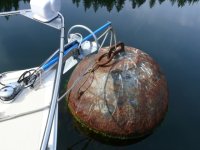RobMcClain
Member
The last time we cruised the San Juan Islands we took advantage of a mooring buoy in one cove. It was easy, secure, and restful until the wind was calm and current slack. I then found the boat and buoy would occasionally drift together, often at 2:00 am. When this occurred the buoy would periodically bang against the hull. I noticed the large yachts moored nearby had their line(s) to the buoy pulled tight up thru the anchor roller to prevent this sort of thing, but the sweep of their bows was enough to naturally hold off the buoy from the hull. The C-dory hull doesn't allow for this. So how to keep some distance? Or, is there a method to tie closely to the buoy with a fender looped between? Doing some internet research on this matter I found one guy who uses a stiff pool noodle with the line to/from the buoy run thru the hole in the noodle. He said the stiffness of the noodle is enough to hold the boat at an ample distance. I know many of you often take advantage of the mooring buoys and I am curious if you have a method for preventing the periodic hull contact. I have little experience with buoys so I may well have been doing something wrong. What are the best practices and/or tricks? Thanks!
Rob
Rob



